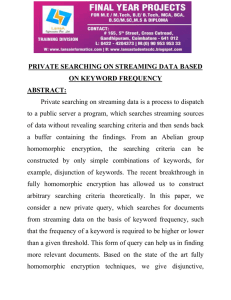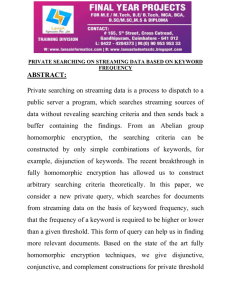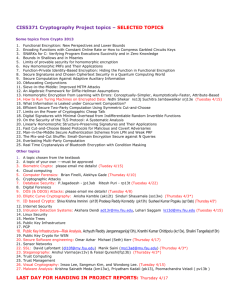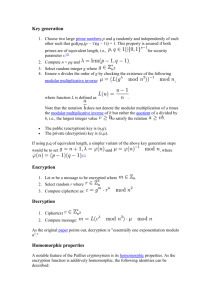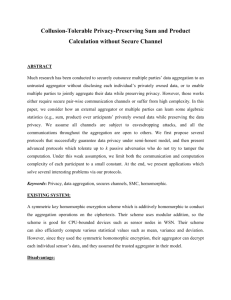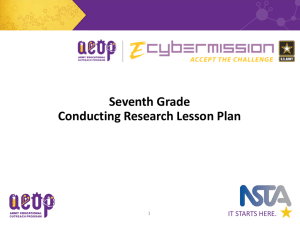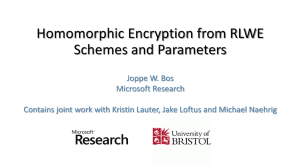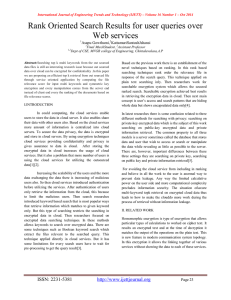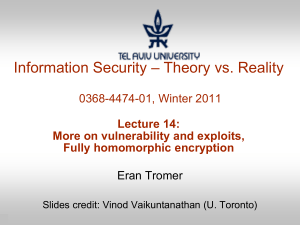S/W System Configuration
advertisement
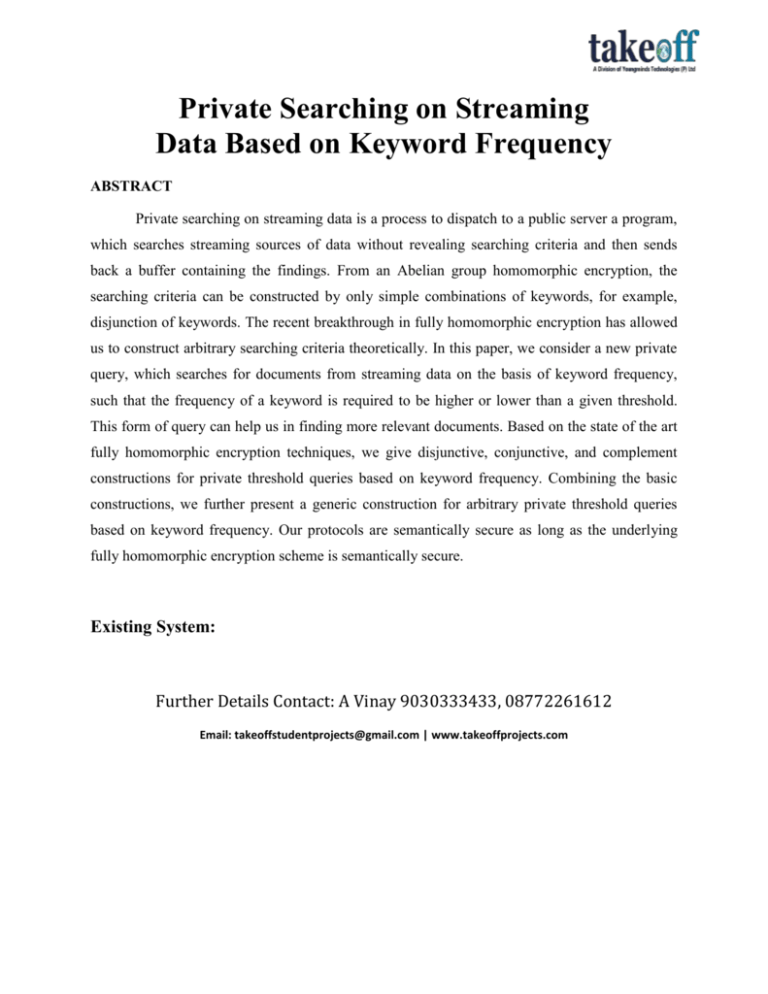
Private Searching on Streaming Data Based on Keyword Frequency ABSTRACT Private searching on streaming data is a process to dispatch to a public server a program, which searches streaming sources of data without revealing searching criteria and then sends back a buffer containing the findings. From an Abelian group homomorphic encryption, the searching criteria can be constructed by only simple combinations of keywords, for example, disjunction of keywords. The recent breakthrough in fully homomorphic encryption has allowed us to construct arbitrary searching criteria theoretically. In this paper, we consider a new private query, which searches for documents from streaming data on the basis of keyword frequency, such that the frequency of a keyword is required to be higher or lower than a given threshold. This form of query can help us in finding more relevant documents. Based on the state of the art fully homomorphic encryption techniques, we give disjunctive, conjunctive, and complement constructions for private threshold queries based on keyword frequency. Combining the basic constructions, we further present a generic construction for arbitrary private threshold queries based on keyword frequency. Our protocols are semantically secure as long as the underlying fully homomorphic encryption scheme is semantically secure. Existing System: Further Details Contact: A Vinay 9030333433, 08772261612 Email: takeoffstudentprojects@gmail.com | www.takeoffprojects.com Private searching on streaming data is a process to dispatch to a public server a program, which searches streaming sources of data without revealing searching criteria and then sends back a buffer containing the findings. From an Abelian group homomorphic encryption, the searching criteria can be constructed by only simple combinations of keywords, for example, disjunction of keywords. The recent breakthrough in fully homomorphic encryption has allowed us to construct arbitrary searching criteria theoretically. Disadvantages 1. This problem has many applications for the purpose of intelligence gathering. 2. It gathering the bundled of data. Proposed System In this project, we consider a new private query, which searches for documents from streaming data on the basis of keyword frequency, such that the frequency of a keyword is required to be higher or lower than a given threshold. This form of query can help us in finding more relevant documents. Based on the state of the art fully homomorphic encryption techniques, we give disjunctive, conjunctive, and complement constructions for private threshold Further Details Contact: A Vinay 9030333433, 08772261612 Email: takeoffstudentprojects@gmail.com | www.takeoffprojects.com queries based on keyword frequency. Combining the basic constructions, we further present a generic construction for arbitrary private threshold queries based on keyword frequency. Our protocols are semantically secure as long as the underlying fully homomorphic encryption scheme is semantically secure. Advantages: 1. This helps to searching the private data effectiveness and accuracy. 2. Although a trade-off between utility and privacy is necessary, it is hard, if not impossible, to find a proper balance overall. Besides, it is hard to prevent irrelated data proactively collecting intelligence on the search engine. IMPLEMENTATION Further Details Contact: A Vinay 9030333433, 08772261612 Email: takeoffstudentprojects@gmail.com | www.takeoffprojects.com from Implementation is the stage of the project when the theoretical design is turned out into a working system. Thus it can be considered to be the most critical stage in achieving a successful new system and in giving the user, confidence that the new system will work and be effective. The implementation stage involves careful planning, investigation of the existing system and it’s constraints on implementation, designing of methods to achieve changeover and evaluation of changeover methods. Main Modules:- 1. User Module : In this module, Users are having authentication and security to access the detail which is presented in the ontology system. Before accessing or searching the details user should have the account in that otherwise they should register first. 2. Fully Homomorphic Encryption: Further Details Contact: A Vinay 9030333433, 08772261612 Email: takeoffstudentprojects@gmail.com | www.takeoffprojects.com Previous homomorphic encryption schemes, such as, allow homomorphic computation of only one operation (either addition or multiplication) on plaintexts. Recently, FHE schemes, such as which can support evaluation of arbitrary depth circuits, were successfully constructed. Among them, the somewhat fully homomorphic encryption scheme proposed by 1. KeyGenenation 2. Encrypt To encrypt 3. Decrypt. 3.Construction : In our protocol for disjunctive threshold queries is composed of four algorithms KeyGen, FilterGen, FilterExec, BufferDec. Our construction is based on a fully homomorphic encryption scheme and can be formally presented as follows.Key Generation. KeyGenðkÞ. Run the key generation algorithm for the underlying fully homomorphic encryption scheme to produce the private key sk and the publickey pk. 4. Performance-Analysis: We have presented two basic constructions for threshold query based on keyword frequency. They are disjunctive and conjunctive. In our disjunctive construction, the client can pregenerates the public/private key pair. In addition, the client needs to encrypt the frequency of each classified keyword in the phase of the filter program generation and to decrypt the buffer IB to retrieve the matching documents after the buffer returns. If we do not consider the key generation, the total computation complexity of the client is encryptions to generate the program F and decryptions to retrieve the matching documents from the buffer, where jDj is the number Further Details Contact: A Vinay 9030333433, 08772261612 Email: takeoffstudentprojects@gmail.com | www.takeoffprojects.com of words in the dictionary D, 2d is the maximal number of words contained in each document, ‘is the number of bits of each document, and mis the maximal number of matching documents in the buffer. System Configuration:H/W System Configuration:Processor - Pentium –III Speed - 1.1 Ghz RAM - 256 MB(min) Hard Disk - 20 GB Floppy Drive - 1.44 MB Key Board - Standard Windows Keyboard Mouse - Two or Three Button Mouse Monitor - SVGA Further Details Contact: A Vinay 9030333433, 08772261612 Email: takeoffstudentprojects@gmail.com | www.takeoffprojects.com S/W System Configuration: Operating System :Windows95/98/2000/XP Application Server : Tomcat5.0/6.X Front End : HTML, Java, Jsp Scripts Server side Script Database : Mysql 5.0 Database Connectivity : JDBC. : JavaScript. : Java Server Pages. Further Details Contact: A Vinay 9030333433, 08772261612 Email: takeoffstudentprojects@gmail.com | www.takeoffprojects.com
